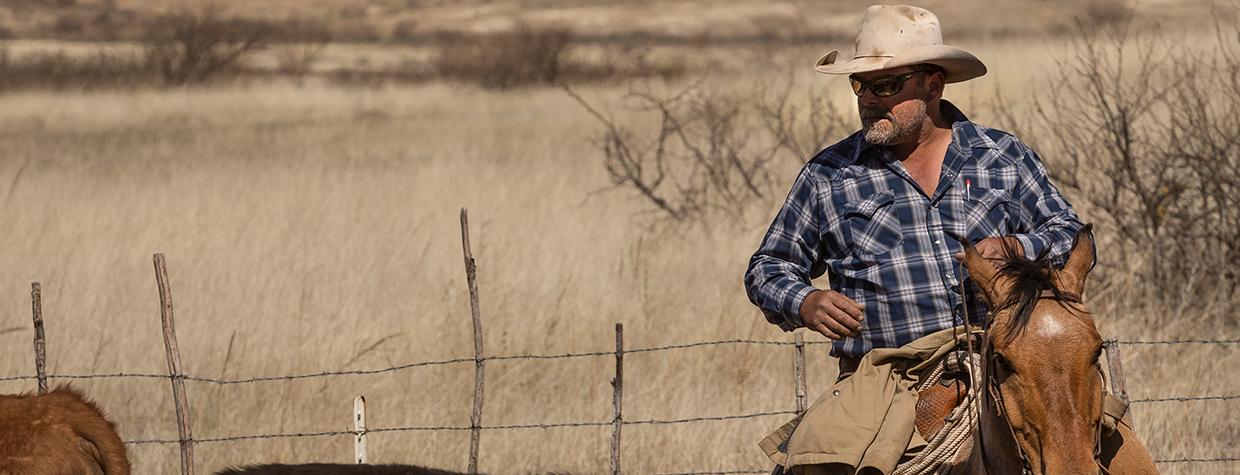Vast and flat, Southeastern Arizona’s Sulphur Springs Valley stretches for 65 miles, from its northwest section along the Galiuro and Piñaleno mountains to its southeast end just west of the Chiricahua Mountains. Tucked within that valley, which is well known for its variety of plant and animal species, is the Sierra Bonita Ranch. As it celebrates its 150th anniversary this year, the Sierra Bonita wears the crown as the state’s oldest continuously operating cattle ranch.
Henry Clay Hooker, known by the honorary title “Colonel Hooker,” established the ranch in 1872, on the site of a Spanish estate that had been decimated by Chiricahua Apache raiders decades prior. Hooker, who had moved to Arizona from California in the late 1860s, partnered with Captain Hugh Hinds, who was well known to Hooker already. Together, the men became the largest suppliers of beef to military outfits that were stationed in the Arizona Territory. That cattle operation began with Texas longhorns and Mexican corrientes, then evolved to Durham, or shorthorn, cattle.
Despite frequent raids and cattle loss, Hooker ultimately amassed more than 250,000 acres of land, including holdings in Graham and Cochise counties. Sometime in the 1880s, he made the switch to Herefords, which remain the foundation of the operation today. That operation is led by Jesse Hooker Davis, a sixth-generation rancher on the Sierra Bonita. For him, continuing his family’s tradition is as much an honor as it is crucial.
In photographer Scott Baxter’s 2012 book, 100 Years 100 Ranchers, Davis is quoted as saying, “This is bigger than me. It isn’t about me. It’s just my turn to take care of it.” Now, a decade later, Davis expands on that sentiment.
“Being a legacy operation in any business is definitely something special and unique,” he says. “I sometimes lose sight of the generations that have come before me when I’m just trying to make the business work on a daily basis, but in reality, it’s exactly what drives me to succeed, strive to be sustainable and represent the cattle business and agriculture in a favorable and beneficial way. The passion, hard work and drive runs through my veins, thanks to my forefathers.”
According to a 2017 report cited by the Arizona Department of Agriculture, agriculture contributes $23.3 billion to the state’s economy annually. That figure is in spite of a slew of trials the industry faces — from drought and water-rights issues to legal challenges from environmental advocacy groups. And now, as inflation continues to rise, the cost of feed and other supplies is soaring, too.
“For an operation in agriculture to survive, you have to constantly adapt — most notably to what Mother Nature presents on both a daily basis and seasonally,” Davis says. “Pressure has mounted in opposition to the rearing of domesticated animals, and it’s a constant reminder that the agricultural community still needs to commit further to informing the general public of the expansive benefit and influence cattle bring to their lives and the economy.”
The Sierra Bonita Ranch is also recognized as one of the oldest cattle ranches in the United States, and it was designated a National Historic Landmark in 1966. According to the National Park Service, which administers the program: “The National Historic Landmark is 320 acres at Sierra Bonita Ranch that contain the historic ranch buildings, which are the main house, bunkhouse, adobe corrals, and barns. … Made of adobe (straw and clay) bricks, the house is a three-sided U-shaped building that wraps around a central patio enclosed by a wall. … Initially, the house had no doors or windows on its exterior walls with access only from the patio, but the Hooker family added exterior openings after the threat of marauders and the Apache subsided.”
While his great-great-great-grandfather, Colonel Hooker, famously allowed Wyatt Earp and his posse to stay at the Sierra Bonita as they fled from authorities in 1882 and even intervened with the governor on their behalf — a role in history that led to Charlton Heston playing Hooker in the film Tombstone — Davis’ focus now is purely on maintaining the integrity of the ranch.
“My hopes are to continue to make a positive influence on my community and industry,” he says, “through being an advocate for the cattle business, by focusing on sustainability and upholding proper environmental standards that allow for the health and wellness of the cattle, as well as the landscape and wildlife.”

